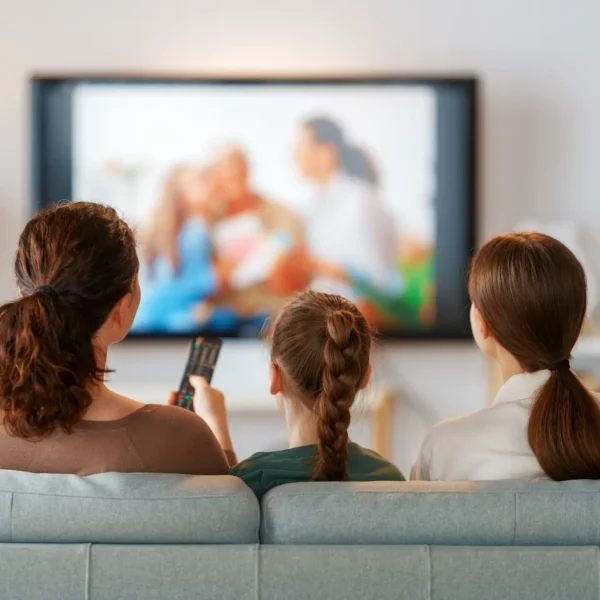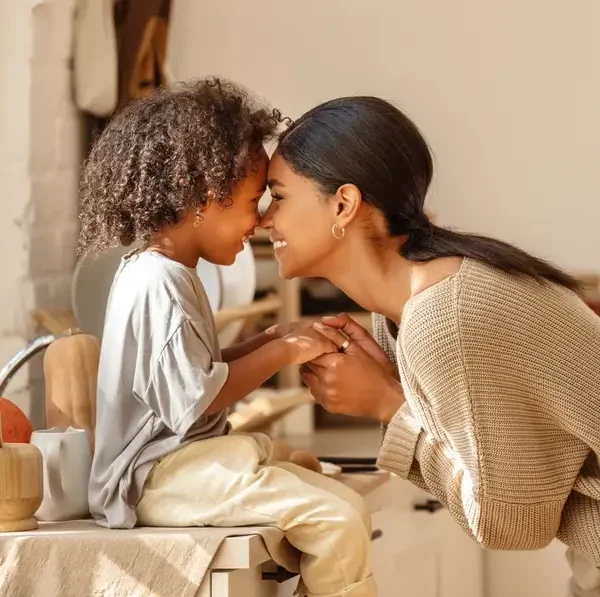
Let’s face it: managing screen time has become one of the biggest stressors in modern parenting.
Between phones, YouTube, video games, social media, and the ever-expanding digital world, it can feel like you’re up against an overwhelming force. Add in the constant pressure to “get it right,” and it’s no wonder so many parents feel frustrated, guilty, and overwhelmed.
If you’ve ever asked yourself…
- “Is this too much screen time?”
- “Is my child addicted?”
- “Is this content harmful?”
- “Why does this always turn into a fight?”
…know that these are incredibly common and valid questions I hear from parents everyday. (Whether they have a toddler or a teen.)
And yet, when we lead from a place of constant worry or try to control every click, the power struggles only gets worse.
The key isn’t cracking down harder. It’s shifting the way we think about screen time altogether.
Here are 5 important mindset shifts to help you create calmer, more confident boundaries around screens without all the guilt, arguments, and shame.
1. Screens Aren’t All Bad
Yes, you read that right.
Screens get a bad rap, but not all screen use is automatically harmful. In fact, a lot of screen time is relaxing, educational, social, skill-building, and fun! Whether it’s a family movie night, a documentary, a FaceTime call with grandparents, or a challenging video game level, screens can serve many healthy purposes.
And don’t forget the benefits you gain from your child’s screen time. Those can’t be minimized or ignored. If your child is safely engaged with a screen while you cook dinner, catch up on work, or simply take a breather, you’re not failing at all. You’re using screens as a helpful tool.
Let’s stop labeling all screen use as simply “bad” and instead, shift our mindset to include a more nuanced, balanced approach.
2. Don’t Fear Screens. Learn to Navigate Them
Screens are here to stay. That’s why the goal is not to eliminate them altogether. The goal is to understand them, set healthy boundaries around them, and use them to our advantage.
Leading with fear or shame isn’t sustainable (or helpful!). Instead of trying to avoid the digital world, we can learn to navigate it.
Ask yourself: How can I use this as an opportunity to teach my child real-life skills like decision-making, communication, and balance? How can I make this work for my family and our unique needs? How can we all enjoy this without feeling guilty or fighting?
Our children’s social lives, education, and entertainment often involve screens. The more we resist that reality, the more we create conflict and confusion. Let’s work with it, not against it. Let’s use it as a tool for connection and communication.
3. Don’t Talk Down What Your Child Loves
If you’ve approved a show, game, or YouTuber, avoid belittling it, even if you don’t get it.
Saying things like “How do you watch this?” or “This is junk” sends a message that what your child enjoys doesn’t matter to you. It creates disconnection when what you want is the opposite.
Instead, use screen time as a bridge. Sit next to them. Ask genuine questions about the game. Watch together. Be curious. Show interest.
This doesn’t mean you have to love it. It just means you care about them and what they care about.
4. Don’t Use Screens as Rewards or Punishments
This is a tough one, but it’s very important. It’s easy to fall into the trap: “If you clean up, you get iPad time.” Or, “Talk to me like that again and no more video games this week!”
While this may seem to work in the short term, using screens as leverage actually increases their perceived value and makes intrinsic motivation harder to develop.
Even more importantly, it can undermine your parental authority. When screens become the only thing your child responds to, you lose influence, and the screen gains it.
Instead of controlling behavior with screen access, work on clear boundaries, direct communication, and consistent expectations.
5. Your Best Tool Is Connection
Yes, parental controls matter. Yes, time limits are important. But your #1 tool in navigating screen time (especially as your child gets older!) is a strong, connected relationship with open communication.
That means:
- Creating an open, non-judgmental space for conversation.
- Being someone your child feels safe turning to, even when they’ve made a mistake.
- Building trust so your child comes to you, not just Google or friends.
When your child knows you’re available, understanding, and curious – not just controlling – they’re far more likely to listen to your guidance and come to you when something doesn’t feel right.
From Mindset Shift To Action: Now What?
If you take one thing from this blog post, let it be this: You don’t need to fear screens.
You can create a screen time plan that works for your family, keeps your child safe, takes into account all the other activities they’re involved in, and supports your values. And once you do, you deserve to feel confident in it.
If you find yourself needing support, I offer you all the tools you need inside my Everything 3-7 Course, including:
- Creating your family’s screen plan,
- Deciding what (and how much) works for your child,
- Setting clear and consistent boundaries,
- Navigating pushback,
- Supporting your child through transition when it’s time to turn the screen off
Managing screen time is about being intentional, connected, and confident in your approach. With these mindset shifts and tools, you’ll find fewer meltdowns, fewer battles, and more meaningful conversations.
When my three boys were younger, they’d come home from school and unwind with Power Rangers, Batman cartoons, and more. It was their designated time to decompress after a long day of learning, listening, and socializing. They new what they could watch, for how long, and even turned it off themselves when they were done.
We had a clear plan. One that we created together, with me in the lead. I set specific boundaries and I had my tools ready to handle any pushback that came my way.
If you’d like to create that kind of calm, confident screen time plan in your home, you’ll find all the tools and guidance inside my Everything 3–7 course.
 What’s The Difference Between A Threat And A Boundary?
What’s The Difference Between A Threat And A Boundary? The 6 Parenting Principles That Will Transform Your Parenting Journey
The 6 Parenting Principles That Will Transform Your Parenting Journey



